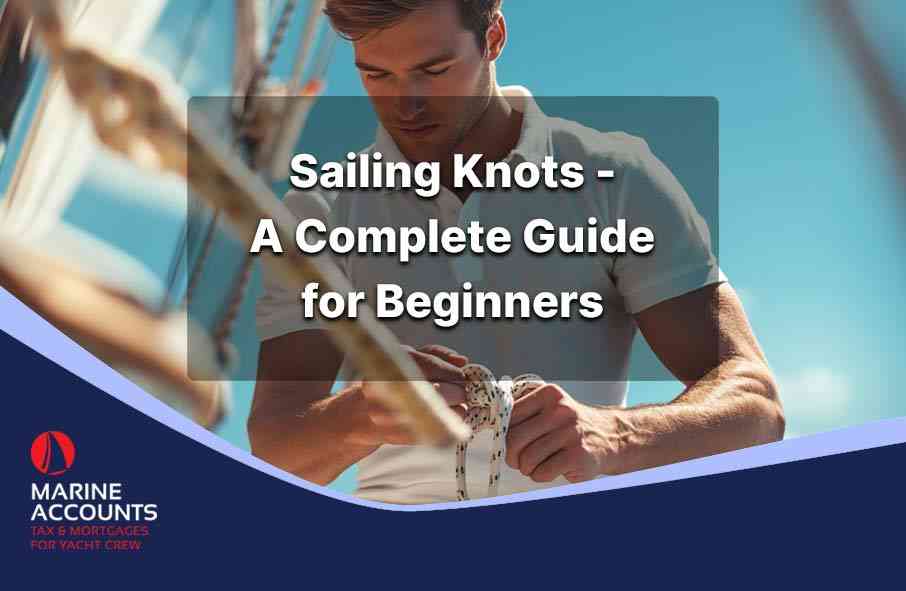Sailing Knots - A Complete Guide for Beginners
- Authors
-
-

- Name
- Patrick Maflin
-

Knowing how to do nautical knots is a must for any sailor.
However there are several nautical knots that one can make, and it is crucial to bear in mind that the knot needs to be done properly, both for safety and reliability purposes.
Knots are an imperative element for various boating activities, including berthing, mooring, managing sails, securing lines, towing another sea vessel, and to prepare for a storm.
Chapters
- Types of Nautical Knots
- Alpine Butterfly Bend
- Alpine Butterfly Loop
- Anchor Hitch
- Ashley Stopper Knot
- Bowline Knot
- Bowline on a Bight
- Buntline Hitch
- Carrick Bend
- Chain Splice
- Cleat Hitch (Dock Line)
- Cleat Hitch (Halyard)
- Clove Hitch - Rope End
- Constrictor Knot (Twisting Method)
- Double Overhand Stopper
- EStar Stopper Knot
- Eye Splice
- Figure Eight Knot
- Halyard Hitch
- Heaving Line Knot
- Icicle Hitch (Loop Method)
- Lighterman’s Hitch
- Midshipman’s Hitch
- Pile Hitch
- Rat-Tail Stopper Knot
- Reef Knot
- Rolling Hitch
- Round Turn & Two Half Hitches
- Running Bowline
- Sheet Bend
- Soft Shackle
- Soft Shackle (Edwards)
- Stopper Knot
- Two Half Hitches
- Trucker’s Hitch
- Zeppelin Bend
- Frequently Asked Questions
- Conclusion
Types of Nautical Knots
 A Deckhand Ties a Sailing Knot
A Deckhand Ties a Sailing Knot
There are several types of nautical knots and one can say that you are spoilt for choice.
However, the choice of the nautical knots you use depends on various factors, including your years of experience, the complexity of the knot itself, and the application.
To make things a bit simpler, it is a good idea to classify nautical knots in three categories:
- Knots which are tied on the end of a line - these are known as ‘knots’.
- Knots that are used to join two lines together - these usually have ‘bend’ in their name.
- Knots that secure a line to a cleat, stanchion or piling - these are known as ‘hitches’.
We shall be outlining the various kinds of nautical knots in alphabetical order hereunder.
Most of the knots below are brilliantly demonstrated using the great work by AnimatedKnots on their YouTube channel.
Alpine Butterfly Bend
The Alpine Butterfly Bend is a reliable bend that is commonly used to join two ropes which are of about the same size together. Simply wind one rope around one hand in a way that the join is by your fingertips. Go around again and fold the join back, and then up underneath the other rope. Afterwards, push the knot off your hand and tighten it up. Last but not least, release the temporary join. This knot can be untied even after having been heavily loaded.
Alpine Butterfly Loop
This is essentially a secure loop that is made in the middle of a rope. Start by wrapping the rope around your hand twice. At the end of the first turn place the rope close to your fingertips. Proceed around, and complete the second turn near your thumb. Pick up the turn that is near your fingertips and wrap it around the other two turns. Finally, slide the knot off and tighten it by pulling the loop at the ends. The Alpine Butterfly Loop is relatively easy to tie and it is also quite easy to undo.
Anchor Hitch
The Anchor Hitch is a great knot to attach an anchor line to an anchor. You will need to pass the tail twice around the post. Make sure to keep the second turn slack. Then, pass the tail over the standing end, and underneath the first slack turn so as to tie the first Half Hitch. Proceed around the standing end to tie the second Half Hitch. The knot will be ready then.
Ashley Stopper Knot
The Ashley Stopper Knot is a rather bulky stopper at the end of a rope. It is quite easy to tie, but also rather easy to get it wrong too so it is important to proceed carefully. First, make a bight and fold it to have two loops. Then, pass the loop in the standing end through the other loop. Follow this up by tucking the tail through. Tighten up the Half Knot, and then pull the tail tight. Do this to the standing end too.
Bowline Knot
The bowline knot is one of the most versatile and commonly used boating knots. The bowline knot creates a secure and strong loop which will neither slip nor bind under strain. This boating knot is generally used whenever one needs to create a fixed loop at the end of a line, or to make a temporary loop in the middle of a line. Tying two bowlines will allow you to connect two lines.
To tie up a bowline you will need to form a closed loop in the line, leaving the working end to pass over the standing end. The working end needs to be passed through the loop, and around behind the standing end, and finally back into the loop. Then just give a hard pull to close the knot up tightly.
The best thing about the bowline knot is that no matter how tight it gets after being loaded, it can still be easily untied since you just have to turn the knot over and bend it downwards.
Bowline on a Bight
This makes a secure loop in the middle of a rope. You can rest assured that it will neither slip nor bind. It is easy to tie as long as you follow these steps. First, form a bight in the middle of the rope. Make a loop, and then pass the end of the bight through the loop. Open up the bight, bring it around the knot till it encircles both ends. Finally, tighten it up.
Buntline Hitch
The Buntline hitch was originally used to join buntlines to the foot of square sails. To form it, start by passing the tail around the pole and make a complete turn around the standing end. Follow up by going through the hole next to the pole. To complete the knot, form a half hitch. The Buntline Hitch is a secure option when using traditional ropes, and it is very resistant to being shaken. The main drawback is that it cannot be tied under a load.
Carrick Bend
The Carrick Bend is commonly used to join two ropes. With one of the ropes form a loop with the tail under the standing end. Pass the other rope under the first rope, and then over, and again under. Thread the tail of the second rope across the loop by passing it under itself. Finally pull both the ends so as to tighten up the knot. The Carrick Bend may not be the simplest knot, but it is easy to undo.
Chain Splice
The Chain Splice is used when you need to attach a three-strand rope to an anchor chain. Start by taping the rope, unraveling enough for at least five tucks. Pass the strands into the chain, with one of them one way, and the other two the other way. Splice each one back into the standing end of the rope. Repeat this process for the second set of tucks, and then the third and fourth. For added security you can use between five and seven sets of tucks.
Cleat Hitch (Dock Line)
The cleat hitch, as the name itself implies, is used to secure lines to the cleats on the vessel. It is a knot that is easy to make, yet offering a secure way to tie off a line. It is also ideal as it enables you to adjust the tension, thus being commonly used for docking, as well as mooring and anchoring. Simply take one full turn around the object that the line is being secured to. Then, pass it over itself to take another turn. Finish off the knot by tucking the working end underneath itself and pulling tightly.
Cleat Hitch (Halyard)
This version of the cleat hitch is used for halyards and clotheslines. Just pass the rope around the bottom horn, and then on around over the top. Proceed down to the middle part, and then go up across once more. Finally, twist a loop in the rope to hook it on the cleat as a half hitch. It is important to take into account that a halyard may be subjected to a considerable load and hence it is important to tighten the halyard well.
Clove Hitch - Rope End
This boating knot is also quite popular. It is generally used to temporarily attach a line to a pole, or to a post, or even to another line. The clove hitch knot has the advantage of being simple to tie as well as to untie, yet it still provides a secure grip. When one needs to dock a boat, or secure fenders, the clove hitch knot is a common choice.
Constrictor Knot (Twisting Method)
Twist the rope to form a figure eight. Allow it to be a loose form. Then, fold the loops down round the centre so as to form the constrictor knot. This is a great temporary knot, such as when you are trying to keep a rope’s ends together, tie up the neck of a sack, or as a temporary hose clamp. However it can only be used if the surface for the binding turn is a curved one. Also, it can prove to be quite hard to untie it, often leading to cutting as the only way to remove it.
Double Overhand Stopper
The Double Overhand Stopper makes for a reliable stopper knot. It is quite a large knot. To form it you will need to create a loop in the rope, and pass the end through it. Follow this by passing the end through the loop once more, and tighten up the knot so as to have a secure stopper knot. This is essentially an overhand knot, with an added turn. It is often used to improve the security of other knots.
EStar Stopper Knot
This type of knot is ideal when the rope being used is a slippery type of rope. It is reasonably simple to tie, but it has the disadvantage of being rather difficult to untie after heavy loading. However if you have a Dyneema this is the only type of knot that doesn't slip. You will need to wrap the tail end around the standing end, and then on again around itself. Proceed to go around the standing end, and underneath itself to make a buntline hitch. Afterward, pass the tail end through the buntline hitch, and follow up across the two loops that were created. Finally tighten up the buntline, and then the standing end, and the tail end.
Eye Splice
The eye splice is a reliable loop in the end of a three or four strand rope. You will first need to tape the rope. Then, unravel enough for five tucks. After arranging the strands, pass the central one under a standing strand. Then, pass a lower strand underneath a lower adjacent standing strand. Proceed by passing the upper strand under the upper strand. You will need to repeat this whole process for all the remaining sets of strands.
Figure Eight Knot
The figure eight knot is one of the most fundamental boating knots for a sailor. This knot prevents the line from slipping through since it creates a stopper knot at the end of the line. It is simple to tie too. First pass the tail over itself in order to form a loop. Proceed under and then around the standing end. Finally complete the knot by passing the tail downwards through the loop. The figure eight knot is ideal as a stopper knot to prevent a line from sliding out of sight, such as inside a mast.
Halyard Hitch
The Halyard Hitch is a compact knot that is commonly used to join a halyard to a shackle at the top of a sail. You will first have to pass the tail through the shackle. Then, pass twice round the standing end. Proceed by passing the end through the loop that is next to the shackle. Pull as tightly as you can. Trim and heat-seal the end in order to close the knot.
Heaving Line Knot
The heaving line knot is a simple and rather heavy heaving knot. You will need to prepare a sufficient length of rope. Then, make a bight and hold it, ensuring that it enclosed the tail end. Afterward, wrap it around two strands, and then around the remaining strand till you use up the tail end. The heaving line knot can then be completed by passing the tail end through the loop.
Icicle Hitch (Loop Method)
The Icicle Hitch makes for an extremely secure slide and grip knot. It is ideal to grip on tapered poles for instance. You will need to wrap the rope around the pole. Make four turns, always moving away from the end of the pole. Then, leave a loop hanging and pass the end back over the pole in a way that it is alongside the standing end. After, pass the loop behind the two ends and hook it over the pole. Complete by tightening up the knot. It is important that the final load is parallel to the pole. This type of knot grips even smooth surfaces extremely well and it is easy to tie up.
Lighterman’s Hitch
The Lighterman’s hitch is generally the best choice to secure a tow line to a bollard. Simply wrap the rope twice around the bollard. Then, pass the bight underneath the standing end, and then over the bollard. Wrap another turn around the bollard, and proceed by passing a bight under the standing end and again over the bollard. You can continue by adding more turns as required. The Lighterman’s hitch is easy to tie and it can also be easily untied and eased out as you remove each turn that was made. Hence you can control the load very well.
Midshipman’s Hitch
This is a very popular adjustable loop which can be tied using a rolling hitch. First, pass the tail end round the standing end, and repeat again. Then, tuck it in beside the first turn. Pull it up to form an Awning hitch. Proceed by continuing around and then tie half a hitch. If this is made in a reverse direction it will be an adjustable hitch. The main benefit is that the loop created is adjustable and so it can be slid up or down but still holding up securely. It is also relatively easy to tie and untie. Even after having been heavily loaded you will find that you can still release it quite easily.
Pile Hitch
The pile hitch is an easy way to attach mooring lines to dock posts. It is also used to make rope fences. All you need to do is pass a bight of the rope round a pole and under the standing end. Then, drop the bight over the top of the pole and tighten the hitch in order for the standing end to take the load.
Rat-Tail Stopper Knot
The rat-tail stopper knot is commonly used to take mooring lines’ loads during the transfer to the Bitts. When a load is taken off the winch, this knot is a common choice. The line gets passed around the first bitt, followed up by a number of figure eight turns around both Bitts. In the end, a complete turn is made around the second bitt. This is also known as the double-ended version.
Reef Knot
The reef knot, or as it is sometimes referred to, the square knot is used to secure two lines of equal size together. As a result, it is a popular choice for reefing sails, and to tie bundles together, for example. It is easy to tie and to untie, making it a versatile knot used by many sailors for various applications.
Rolling Hitch
The rolling hitch is another essential knot. It is designed not to slip and thus often used to keep a line secured to a vertical cylindrical object such as a stanchion for example. It is also ideal to form like a noose that will not slip under a load, such as when you need to secure tie-downs for an awning on deck. To tie this knot you will first need to wrap a line twice around a post, or to another fixed line. Then, take a third turn by passing the working end of the line over its standing end, following around the second line above the initial two turns. Finally pull on the standing part of the first line.
Round Turn & Two Half Hitches
This is a great way to secure a rope to a ring or a post. First, pass the end around the post twice. Then, go round the standing end so as to make the first half hitch, and pull it tightly. Continue round in the same direction in order to make the second half hitch. Pull it tightly to complete the knot.
Running Bowline
The running bowline is a good way of tying a noose that will neither bind nor slide undone easily. This is great when it comes to retrieving rigging or lumber or other objects that may have fallen overboard. To make it, just pass the rope over a pole and form a loop in the tail end. Then, pass the shorter end round the standing end, then through the loop, around itself, and back through the loop. In this way you would have formed the bowline. Finally, pull on the standing end so as to run the bowline up against the pole.
Sheet Bend
This boating knot is used to join two lines that are of a different size or material to each other. Some examples include attaching a small line to a larger line, or when you need to attach a jib sheet to a clew, or even to join anchor lines. The sheet bend knot is a reliable knot which will hold well under tension. To tie the sheet bend, first form a bight at the end of the line. Pass the end of the other line through from beneath, and around behind both parts of the initial line. Then finish off the knot by passing the working end of the second line under itself and pulling the knot tightly.
Soft Shackle
The soft shackle offers a strong and lightweight option instead of a metal shackle. For the soft shackle you will need to use the Edwards calculator to select the most ideal lengths. The main advantage of the soft shackle is that as it weighs little it is much less likely to cause injury should it strike you.
Soft Shackle (Edwards)
This is a variation of the former, made out of hollow-braid rope. Again the Edwards calculator should be used to decide on the lengths needed for the shackle length. The soft shackle is an excellent way of attaching two jib sheets to the jib for example.
Stopper Knot
The stopper knot is the most secure knot to keep a line from getting pulled through a block or rope clutch. This nautical knot is also known as the double overhand stopper knot. This knot does not come loose easily. To tie it up you will need to loop the end of a line twice around the palm of your hand, and tuck the working end under the two loops. Then, pull the loops off. Working your way back to front, pass the working end twice around the palm of your hand. After two full wraps, pass the working end underneath the wraps on your hand, away from the thumb. Afterwards, use the end to pull the knot tight while it slips off your hand.
Two Half Hitches
Two half hitches is quite self-explanatory even from its name. It comprises a one half hitch which is then followed by another half hitch. This knot is easy to tie. It forms a running noose which can be made to be smaller or larger. This is commonly used to tie a line around an object, and if it is combined with a round turn it can also be used to secure a dock line to a piling for example.
To tie this knot you will need to pass the line twice around an object, and then tie one hitch on top of the turns. To do this you would need to pass the working end of the line behind the standing line, and then pull it through. This process will need to be repeated for the second hitch.
Trucker’s Hitch
This is a popular knot, commonly used to secure loads or tarpaulins. Just form a bight and use it to tie a figure eight knot. Pass the tail round the hook and through the figure eight loop. Pull it tight, and complete the knot by making two half hitches below the loop.
Zeppelin Bend
The Zeppelin Bend is ideal to join two ropes together. It avoids the risk of jamming. You will need to form a bight in the two ropes and overlap them. Pass each end around across itself. Then thread both ends past each other through the middle section and tighten up.
Frequently Asked Questions
What knots are required for RYA Level 1?
The RYA Level 1 course covers the most essential knots that a sailor should know. The idea is to ensure that the sailor has a solid foundation of the most important nautical knots that are commonly used in sailing. Knots such as the reef knot, the figure of eight, the bowling and the clove hitch are all included in this course.
What's the most secure sailing knot?
As there are so many different sailing knots to choose from this may not be such a straightforward answer. However, most will agree that the bowline knot is one of the most secure knots as it creates a reliable loop which will not come undone or slip even under a load.
What's the easiest sailing knot to learn?
Nautical knots vary in their complexity, and for a beginner sailor it may be a bit daunting to learn how to tie knots. One of the most straightforward sailing knots is the figure of eight knot. It is easy to tie and considered to be a basic knot any sailor will know how to tie.
Conclusion
If you are about to start working on a superyacht, you might feel a bit overwhelmed at first when it comes to learning how to tie the different nautical knots.
Whether you're an experienced yachtie, a deckhand or a bosun just starting out, learning sailing yachts takes years on hands-on experience.
However over time you will become more proficient, and learn new knots as you gain more experience and confidence.
Disclaimer: Any advice in this publication is not intended or written by Marine Accounts to be used by a client or entity for the purpose of (i) avoiding penalties that may be imposed on any taxpayer or (ii) promoting, marketing or recommending to another party matters herein.






